- About Ficus Rubber-Leaved
- Appearance
- Care
- Propagation
- Pests and Diseases
- Choosing the Right Location
- 1. Light Requirements
- 2. Temperature
- 3. Humidity
- 4. Space
- 5. Toxicity
- Soil and Water Requirements
- Soil
- Watering
- Fertilizer
- Sunlight and Temperature Needs
- Propagation Methods
- 1. Stem Cuttings
- 2. Air Layering
- 3. Leaf Cuttings
- Pruning and Maintenance
- 1. Pruning
- 2. Maintenance
- Common Pests and Diseases
- Pests
- Diseases
- Q&A:
- How often should I water my rubber-leaved ficus?
- Can rubber-leaved ficus adapt to low-light conditions?
- How do I propagate a rubber-leaved ficus?
- What is the ideal temperature for rubber-leaved ficus?
- How do I prevent pests on my rubber-leaved ficus?
- Video: Ficus elastica (rubber tree) burgundy care and propagation (in water and soil) with updates!
The Ficus rubber-leaved, also known as Ficus elastica, is a popular houseplant that is loved for its shiny, rubbery leaves and its ability to tolerate a wide range of growing conditions. This species, native to Southeast Asia, is incredibly versatile and can be grown both indoors and outdoors, making it a favorite among plant enthusiasts.
One of the reasons why the Ficus rubber-leaved is so beloved is because it is relatively easy to care for. This plant thrives in bright, indirect light, making it a great fit for homes and offices with limited natural sunlight. However, it is important to keep in mind that direct sunlight can scorch the leaves, so it is best to place the plant near a window with a sheer curtain or in a well-lit room.
In addition to light, the Ficus rubber-leaved also requires a moderate amount of water. It is essential to keep the soil slightly moist, but not soggy, as overwatering can lead to root rot. A good rule of thumb is to water the plant when the top inch of soil feels dry to the touch. During the growing season, which typically extends from spring to summer, the plant may require more frequent watering.
Another important aspect of caring for the Ficus rubber-leaved is maintaining a consistent temperature and humidity level. This plant prefers temperatures between 60-75°F (15-24°C) and a humidity level of 40-60%. To increase humidity, you can mist the leaves regularly or place a tray of water near the plant. It is also important to protect the plant from cold drafts and sudden temperature changes.
In conclusion, the Ficus rubber-leaved is a beautiful and easy-to-care-for species that can thrive in a variety of conditions. With the right amount of light, water, and temperature, you can enjoy the lush, green foliage of this stunning plant all year round. So, whether you are a beginner or an experienced gardener, the Ficus rubber-leaved is a great choice to add some natural beauty to your home or office.
About Ficus Rubber-Leaved
Ficus Rubber-Leaved, also known as Ficus elastica, is a popular houseplant native to the tropics of Southeast Asia. It is part of the Moraceae family and is known for its large, glossy, rubbery leaves.
This species of Ficus is highly valued for its ornamental appeal and is commonly grown indoors as a decorative plant. It can reach heights of up to 30 meters in its natural habitat, but when grown indoors, it usually stays compact and manageable, typically reaching heights of around 2-3 meters.
Appearance
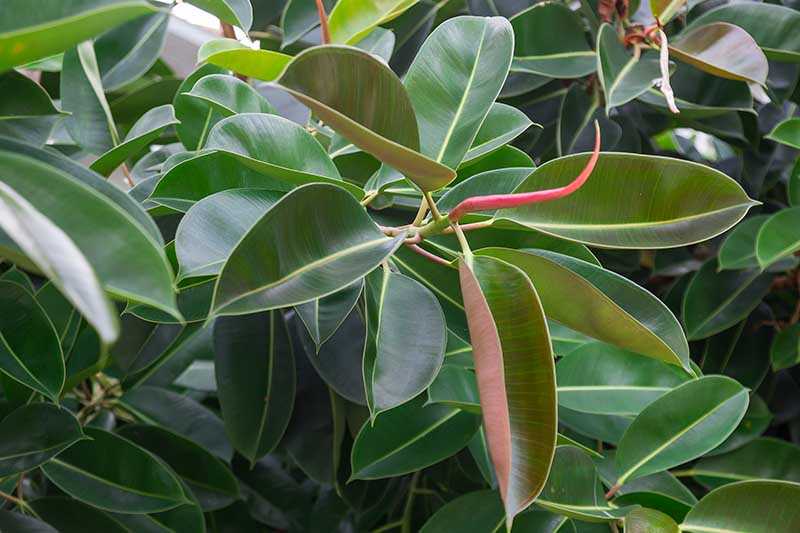
The leaves of the Ficus Rubber-Leaved are its most striking feature. They are thick, waxy, and leathery, with a shiny surface that gives them a rubber-like texture. They are typically dark green, but there are also cultivars with variegated or bronzy-colored leaves.
The plant is also known for its aerial roots, which can grow downwards from the branches and eventually reach the ground, providing additional stability and support.
Care
Ficus Rubber-Leaved is a relatively low-maintenance plant, making it a popular choice for both beginner and experienced gardeners. Here are some key care tips:
- Light: This species thrives in bright, indirect light but can tolerate some shade as well. Avoid placing it in direct sunlight, as the intense rays can scorch the leaves.
- Temperature: Ficus Rubber-Leaved prefers warm temperatures between 65-85°F (18-29°C). It can tolerate slightly cooler temperatures, but it is best to keep it away from drafts or sudden temperature fluctuations.
- Watering: Keep the soil consistently moist but not waterlogged. Allow the top inch of soil to dry out slightly between waterings. During the winter months, reduce watering frequency.
- Fertilizer: Feed the plant with a balanced liquid fertilizer every 2-4 weeks during the growing season (spring and summer). Reduce or stop fertilizing during the winter months.
Propagation
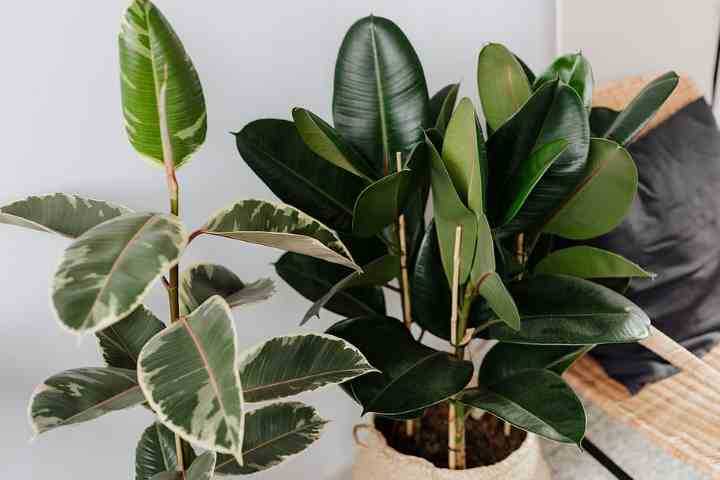
Ficus Rubber-Leaved can be propagated through stem cuttings. Here’s a simple step-by-step guide:
- Select a healthy stem cutting with 2-4 leaves.
- Make a clean cut just below a node (where a leaf is attached).
- Place the cutting in a glass of water or a pot with well-draining soil.
- Keep the cutting in a warm and humid location, away from direct sunlight.
- Roots should start to develop within a few weeks. Once the roots are well-established, the cutting can be transferred to a larger pot.
Pests and Diseases
Ficus Rubber-Leaved is generally a hardy plant, but it can be susceptible to some pests and diseases. Common issues include mealybugs, spider mites, and scale insects. Regularly inspect the plant for any signs of infestation and treat accordingly.
Overwatering can lead to root rot, while underwatering can cause the leaves to wilt and drop. Make sure to strike a balance and adjust the watering routine as necessary.
| Common Issues | Possible Solutions |
|---|---|
| Yellowing leaves | Check for overwatering and adjust watering routine. |
| Leaf drop | Ensure adequate lighting and water levels. Monitor temperature and humidity levels. |
| Pests (mealybugs, spider mites, scale insects) | Treat with appropriate pesticide or insecticidal soap. |
Choosing the Right Location
Choosing the right location for your Ficus Rubber-Leaved plant is crucial for its growth and overall health. Here are some important factors to consider:
1. Light Requirements
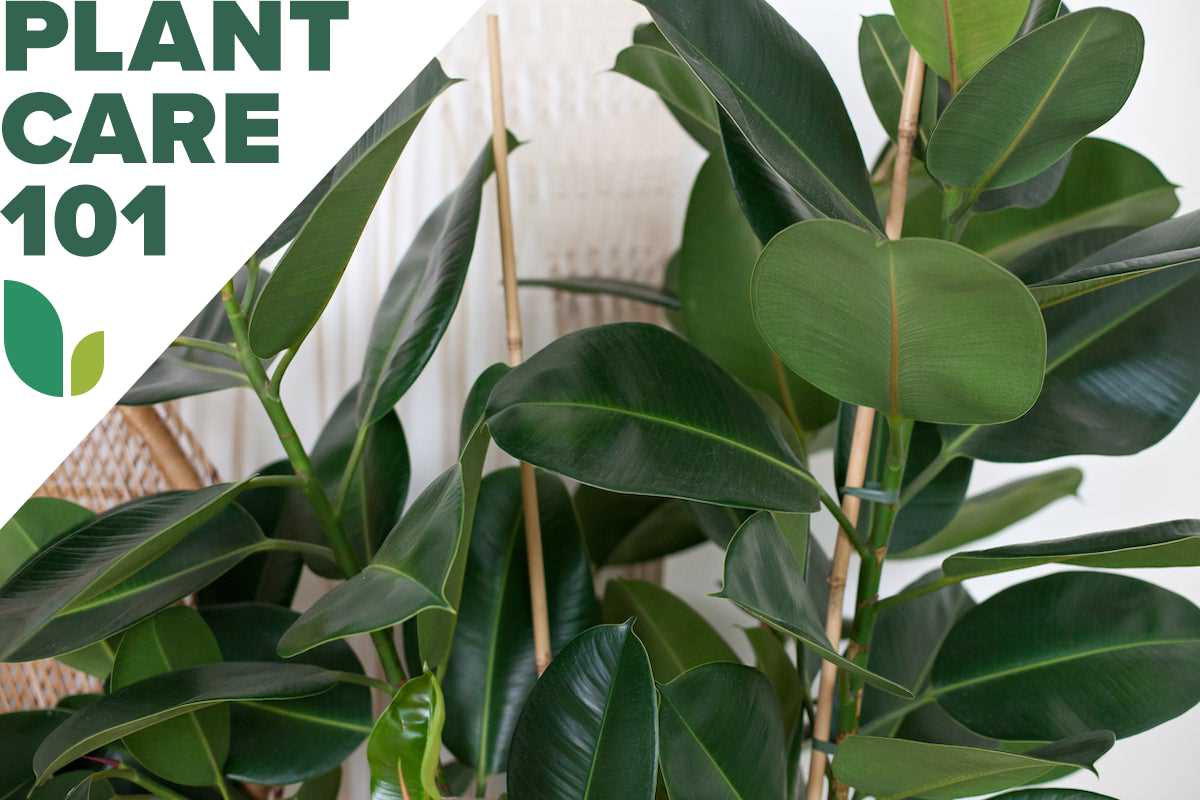
Ficus Rubber-Leaved plants prefer bright, indirect light. Place the plant near a window where it can receive filtered sunlight. Avoid placing it in direct sunlight, as this can cause leaf burn. If you don’t have a suitable location with enough natural light, you can supplement with artificial grow lights.
2. Temperature
These plants thrive in warm temperatures between 60°F to 75°F (15°C to 24°C). Avoid exposing the plant to drafts or temperature extremes, such as near air conditioning units or heating vents.
3. Humidity
Ficus Rubber-Leaved plants prefer higher humidity levels. You can increase humidity by placing a tray of water near the plant or using a humidifier. Avoid placing the plant near air vents or dry drafts.
4. Space
Consider the mature size of your Ficus Rubber-Leaved plant when choosing a location. These plants can grow quite large, reaching heights of 6 to 10 feet (1.8 to 3 meters) indoors. Ensure there is enough space for the plant to grow and spread its branches.
5. Toxicity
Keep in mind that Ficus Rubber-Leaved plants are toxic to pets and humans if ingested. Keep them out of the reach of children and pets, and always wash your hands after handling the plant.
By carefully choosing the right location for your Ficus Rubber-Leaved plant, you can ensure it receives the optimal conditions for healthy growth and longevity.
Soil and Water Requirements

Ficus Rubber-Leaved plants have specific soil and water needs in order to thrive. It is important to provide them with the right conditions to ensure their health and growth.
Soil
The ideal soil type for Ficus Rubber-Leaved plants is a well-draining potting mix. This will prevent the roots from becoming waterlogged and reduce the risk of root rot. You can create a suitable potting mix by combining equal parts of peat moss, perlite, and vermiculite.
It is also important to ensure that the soil pH is slightly acidic, with a pH range of 6.0 to 6.5. You can test the soil pH using a pH testing kit, which is widely available at garden centers. If the pH level is not within the desired range, you can adjust it by adding lime to raise the pH or sulfur to lower it.
Regularly check the moisture level of the soil and water the plant only when the top inch of soil feels dry. Overwatering can lead to root rot, while underwatering can cause the leaves to wilt and drop. Avoid using water that contains high levels of chlorine or fluoride, as these can be harmful to the plant. If possible, use distilled or filtered water for watering.
Watering
When watering your Ficus Rubber-Leaved plant, ensure that you provide enough water to thoroughly moisten the root ball. Water the plant until water drains out of the bottom of the pot and discard any excess water in the saucer. Avoid allowing the plant to sit in standing water, as this can lead to root rot.
It is important to maintain a consistent watering schedule for your Ficus Rubber-Leaved plant. During the growing season, which is typically spring and summer, water the plant more frequently to support active growth. In winter, reduce the frequency of watering to allow the plant to enter a period of dormancy.
Remember to adjust your watering schedule based on the specific environmental conditions and needs of your Ficus Rubber-Leaved plant. Factors such as temperature, humidity, and the size of the plant can all influence its water requirements.
Fertilizer
In addition to proper soil and watering, Ficus Rubber-Leaved plants benefit from regular fertilization. Use a balanced, water-soluble fertilizer with a ratio of 20-20-20 or a specifically formulated houseplant fertilizer.
Dilute the fertilizer to half the recommended strength and apply it to the plant every two weeks during the growing season. Be sure to follow the instructions on the fertilizer packaging for the best results.
However, it is important not to over-fertilize your Ficus Rubber-Leaved plant, as this can lead to salt buildup in the soil and cause damage to the roots. If you notice signs of fertilizer burn, such as brown tips on the leaves, reduce the frequency or strength of the fertilizer application.
Sunlight and Temperature Needs
The Ficus Rubber-Leaved plant thrives in bright, indirect light, making it perfect for indoor environments. Place the plant near a window where it can receive plenty of filtered sunlight throughout the day. Avoid direct sunlight, as it can scorch the leaves.
When it comes to temperature, the Ficus Rubber-Leaved plant prefers a warm and humid environment. The ideal temperature range for this plant is between 65°F (18°C) and 80°F (27°C). Avoid exposing the plant to temperatures below 55°F (13°C) as it can result in leaf drop and growth stunting.
To maintain the right temperature and humidity levels, avoid placing the plant near drafty doors or air conditioning vents. Additionally, you can mist the leaves or use a humidifier to increase humidity levels if necessary.
Overall, providing the Ficus Rubber-Leaved plant with the right amount of bright, indirect light and maintaining a warm and humid environment will help ensure its healthy growth and vibrant foliage.
Propagation Methods
Propagating rubber-leaved ficus plants can be done through various methods. Here are a few common propagation techniques:
1. Stem Cuttings
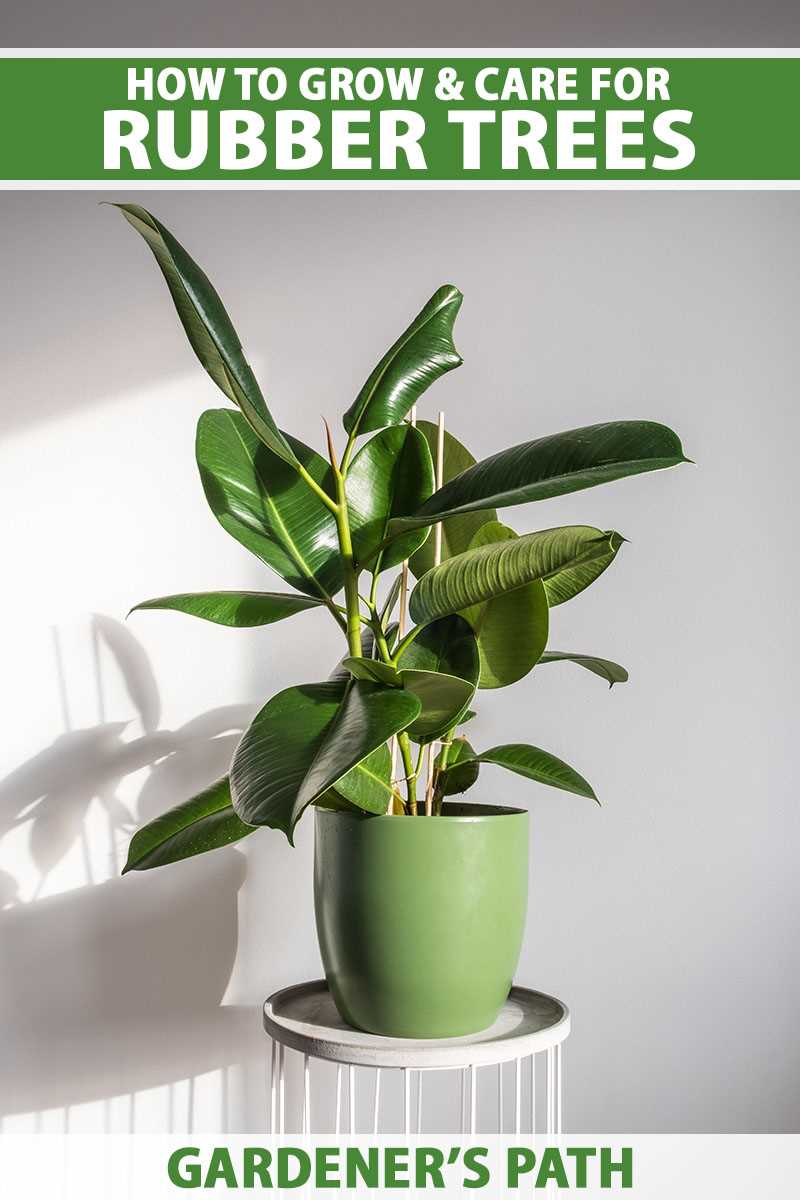
One way to propagate rubber-leaved ficus is by taking stem cuttings. Follow these steps:
- Choose a healthy stem with 3-5 nodes.
- Make a clean cut just below a leaf node.
- Remove the lower leaves, leaving 2-3 leaves on the top.
- Dip the cut end into a rooting hormone powder.
- Plant the cutting in a well-draining potting mix, burying at least one node.
- Place the pot in a warm and bright location.
- Keep the soil moist but not soggy.
- Rooting should occur in 4-6 weeks.
2. Air Layering
Air layering is another effective method to propagate rubber-leaved ficus. Here’s how to do it:
- Select a healthy stem and make a small cut halfway through the stem, just below a node.
- Apply rooting hormone to the cut area.
- Wrap the cut area with damp sphagnum moss, and cover it with plastic wrap.
- Secure the moss and plastic wrap with twine or tape.
- Keep the moss moist and monitor for root development.
- Once roots have formed, cut the stem below the rooted area and plant it in a container with well-draining soil.
3. Leaf Cuttings
Although less common, you can also propagate rubber-leaved ficus from leaf cuttings. Follow these steps:
- Choose a healthy and mature leaf.
- Cut the leaf into sections, each containing a vein.
- Dip the cut end of each section into a rooting hormone powder.
- Plant the sections in a well-draining potting mix, burying them partially.
- Place the pot in a warm and bright location.
- Maintain moisture in the soil and mist the leaves regularly.
- New plants should emerge from the sections after a few weeks.
Propagation methods for rubber-leaved ficus are relatively straightforward and can be achieved with some patience and care. Choose the method that suits your preferences and enjoy expanding your collection of this beautiful plant.
Pruning and Maintenance
1. Pruning
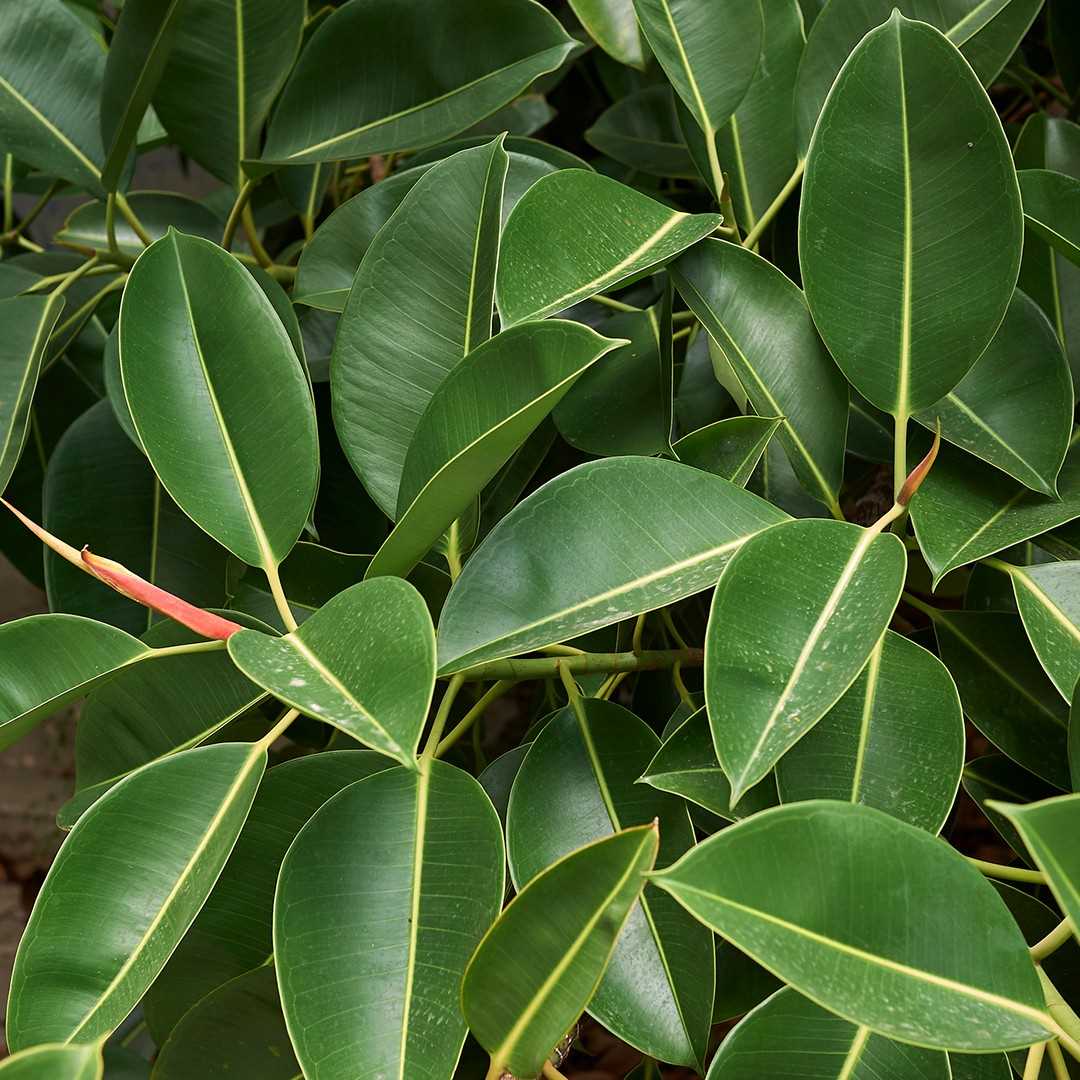
Pruning is an important part of maintaining a healthy and attractive Ficus Rubber-Leaved plant. Here are some tips to follow when pruning your plant:
- Prune regularly to promote bushier growth and to maintain the desired shape of the plant.
- Use clean, sharp pruning shears or scissors to make clean cuts.
- Remove any dead or yellowing leaves by cutting them off at the base of the stem.
- Trim back any long or unruly branches to encourage a more compact and tidy appearance.
- Be careful not to remove more than 1/3 of the plant’s foliage at a time, as this can stress the plant.
2. Maintenance
In addition to regular pruning, there are some other maintenance tasks you should perform to keep your Ficus Rubber-Leaved plant healthy:
- Water your plant when the top inch of soil feels dry to the touch. Be sure not to overwater, as this can lead to root rot.
- Fertilize your plant every 2-4 weeks during the growing season with a balanced, water-soluble fertilizer.
- Keep your plant in a location with bright, indirect sunlight. Direct sunlight can scorch the leaves, while too little light can cause the plant to become leggy.
- Rotate your plant occasionally to ensure even growth on all sides.
- Check your plant for pest infestations, such as mealybugs or spider mites, and treat them promptly with an insecticidal soap or neem oil spray.
By following these pruning and maintenance tips, you can enjoy a beautiful and healthy Ficus Rubber-Leaved plant in your home or garden.
Common Pests and Diseases
Ficus rubber-leaved plants are generally hardy and can withstand some common pests and diseases. However, it is important to be aware of potential problems and take steps to prevent or treat them as needed. Here are some of the most common pests and diseases that can affect your ficus rubber-leaved plant:
Pests
- Mealybugs: These small, white, cottony insects can infest the leaves and stems of your ficus rubber-leaved plant. They suck sap from the plant, causing yellowing and wilting. To get rid of mealybugs, you can try wiping them off with a cotton swab dipped in rubbing alcohol or using an insecticidal soap.
- Aphids: These tiny, pear-shaped insects can gather on the undersides of leaves and suck the sap from your plant. This can lead to distorted growth and sticky residue on the leaves. You can try spraying your plant with a strong jet of water to remove aphids or use insecticidal soap.
- Spider mites: These tiny pests can cause yellowing of leaves and webbing on the foliage. To control spider mites, you can lightly mist the leaves with water, use insecticidal soap, or introduce predatory mites.
Diseases
- Root rot: Overwatering or poor drainage can lead to root rot in ficus rubber-leaved plants. This can cause the roots to become mushy and decayed, resulting in wilting and yellowing leaves. To prevent root rot, make sure your plant is not sitting in standing water and adjust your watering routine if necessary.
- Leaf spot: This fungal disease can cause brown or black spots to appear on the leaves of your ficus rubber-leaved plant. It is often caused by overwatering, high humidity, or poor air circulation. To prevent leaf spot, avoid overwatering and ensure good air circulation around your plant. If leaf spot does occur, remove and destroy the affected leaves.
- Powdery mildew: This fungal disease can appear as a white, powdery coating on the leaves. It thrives in high humidity and can cause leaf distortion and stunted growth. To control powdery mildew, improve air circulation around your plant and avoid overhead watering. You can also treat it with a fungicide if needed.
By regularly inspecting your ficus rubber-leaved plant for signs of pests or diseases and taking appropriate action, you can ensure that it remains healthy and thriving. Remember to always follow the instructions on any pest or disease control products you use, and consult a professional if you are unsure about how to treat a particular problem.
Q&A:
How often should I water my rubber-leaved ficus?
Rubber-leaved ficus plants prefer to have their soil consistently moist, but not waterlogged. Water your plant when the top inch of soil feels dry, usually every 7-10 days. Adjust watering frequency based on the temperature and humidity levels in your home.
Can rubber-leaved ficus adapt to low-light conditions?
Rubber-leaved ficus plants can tolerate low-light conditions, but they thrive in bright, indirect sunlight. If placed in a low-light area, the plant may grow slower and have smaller leaves. To ensure optimal growth, provide your rubber-leaved ficus with bright, filtered light.
How do I propagate a rubber-leaved ficus?
Propagation of rubber-leaved ficus can be done through stem cuttings. Take a 4-6 inch cutting from a healthy, mature plant and remove the lower leaves. Place the cutting in a glass of water or a moist potting mix until roots develop. Once roots are established, transfer the cutting to a pot with well-draining soil.
What is the ideal temperature for rubber-leaved ficus?
Rubber-leaved ficus plants thrive in temperatures between 65-80°F (18-27°C). They prefer slightly warmer temperatures during the day and slightly cooler temperatures at night. Protect the plant from drafts and sudden temperature changes to prevent stress or damage.
How do I prevent pests on my rubber-leaved ficus?
To prevent pests on your rubber-leaved ficus, inspect the plant regularly for signs of infestation, such as yellowing leaves or sticky residue. Keep the plant clean by wiping the leaves with a damp cloth and ensure good air circulation. If pests are present, treat them with insecticidal soap or neem oil.
Video:
Ficus elastica (rubber tree) burgundy care and propagation (in water and soil) with updates!







